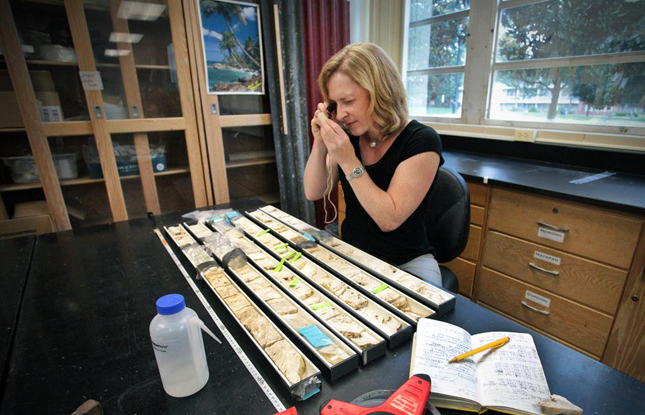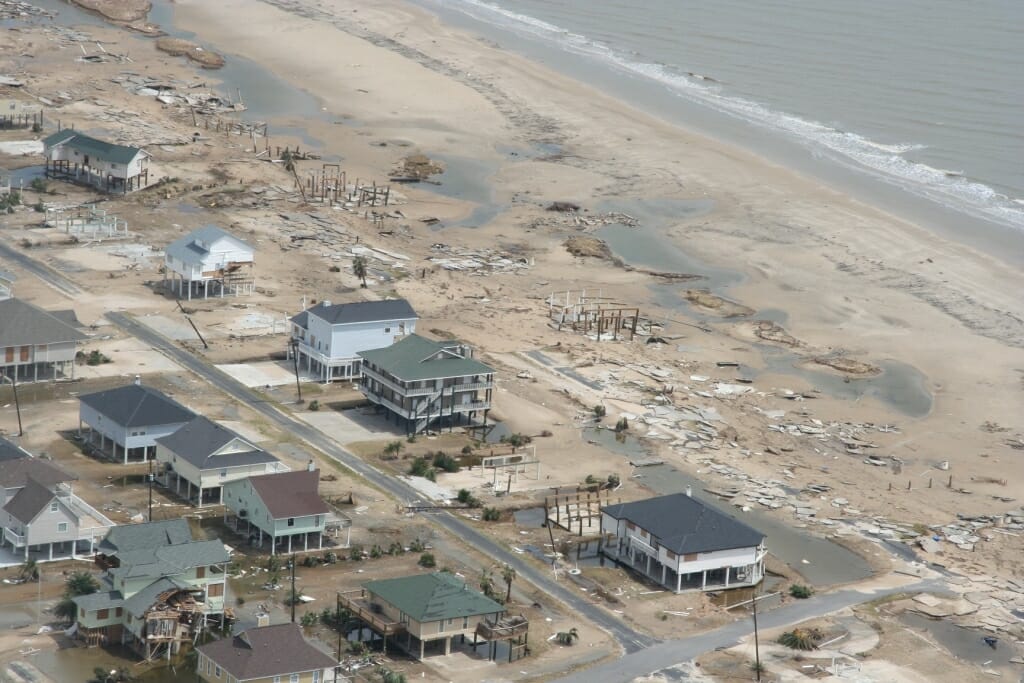UW–Madison scientist helps set national earth sciences research priorities for next decade

Andrea Dutton, examining rock samples at the University of Florida, says, “Earth science issues impact our daily lives in many different ways. So, when policies are developed, it’s imperative they are at least informed and evidence-based so we can make good decisions about what to do” Photo by Erica Brouch
On May 20, 2020, the National Academies of Science, Engineering and Medicine published a report that provides a framework for the next 10 years of research in the earth sciences. Called Earth in Time, its purpose is to define key research priorities and discuss the required infrastructure and partnerships that will be needed to achieve those goals through 2030.
Andrea Dutton, a geoscience professor at the University of Wisconsin–Madison who studies climate change and sea level rise, was a member of the committee tasked with compiling the 172-page community consensus report. She also provided a briefing about the report to members of Congress on May 22.
Dutton describes her experience on the committee, how it worked with extensive community input to arrive at the report’s conclusions, and the importance of studying earth sciences even in the midst of a global viral pandemic.
Q: This is not the first report of its kind. Can you talk about the importance of setting national earth science priorities?
A: There were two previous decadal reports and the purpose is for the National Science Foundation to solicit feedback from the earth science community, to give them guidance for when they propose new programs and justify decisions about their budget. So, they can say: “This is what you told us you want and this is what we’re doing.” It’s the official mechanism to get community-wide input for where (NSF) should be headed in the future.
 Earth science issues impact our daily lives in many different ways. So, when policies are developed, it’s imperative they are at least informed and evidence-based so we can make good decisions about what to do. This requires continuous investment into research initiatives so that we have the necessary knowledge and expertise at hand when urgent situations arise. We can see that now around the globe, how different countries have responded to the COVID-19 pandemic.
Earth science issues impact our daily lives in many different ways. So, when policies are developed, it’s imperative they are at least informed and evidence-based so we can make good decisions about what to do. This requires continuous investment into research initiatives so that we have the necessary knowledge and expertise at hand when urgent situations arise. We can see that now around the globe, how different countries have responded to the COVID-19 pandemic.
Q: Can you share an example of something that has come about because of a previous earth sciences report?
A: It’s very clear these reports have impacted science in a lot of ways. EarthScope came out of one of these reports and it cost many millions of dollars. (EarthScope is an NSF-funded program that deployed thousands of instruments across North America to study geologic processes, including earthquakes and volcanic eruptions.) Some of the results were not anticipated by the people who designed it — for example, signals in how the water cycle changes with drought; the land moves up and down as it gets wet and dries up again. We learned that because we invested in this infrastructure, and these data can shape future research directions.

The Anti-Atlas Mountains of Morocco formed as a result of the collision of the African and Eurasian tectonic plates about 80 million years ago. The Earth in Time report from the National Academies of Science, Engineering and Medicine established 12 priority questions for earth sciences over the next decade, including fundamental understanding of earthquakes and volcanoes. NASA/METI/AIST/Japan Space Systems, and U.S./Japan ASTER Science Team
Q: Can you describe what your role was on the 20-member committee and why you were asked to serve?
A: This was the first time I served on a National Academies committee for a consensus report. I have received funding through EAR (NSF Division of Earth Sciences) and have been funded by their infrastructure side of things for a mass spectrometer; infrastructure is a significant component of the EAR budget. I think it was important to have some members of the committee who are familiar with some of the infrastructure programs as well as the research programs. I also offer disciplinary expertise and have been funded through other related programs at NSF. The committee was also formed to capture a spectrum of diversity across the community.
Q: How did the committee establish the 12 “science priority questions” that are intended to guide the next 10 years of earth science research?
A: We solicited a lot of feedback from the earth sciences community, read white papers and reviews. We brought in early-career researchers and underrepresented groups within the community and consulted with people from industry. We had hundreds of questions to sort through. We looked for the themes that emerged and were poised to advance science over the next decade.
Those questions underscore the fundamentally intertwined nature of Earth’s processes. Earth is an active, dynamic, open system and all components interact to shape the planet. For example, the magnetic field at Earth’s core affects our communications and how we use our cellphones. It’s amazing to think about the connections and relevance to society.
A second theme in the questions is that all these processes operate on broad spatial and temporal scales. A third theme is focused around how having a clear understanding of how the Earth works is central to predicting how present-day changes, both natural and human-driven, are likely to influence human society.
The 12 questions are:
- How is Earth’s internal magnetic field generated?
- When, why, and how did plate tectonics start?
- How are the critical elements distributed and cycled in the Earth?
- What is an earthquake?
- What drives volcanism?
- What are the causes and consequences of topographic change?
- How does the critical zone influence climate?
- What does Earth’s past reveal about the dynamics of the climate system?
- How is Earth’s water cycle changing?
- How do biogeochemical cycles evolve?
- How do geologic processes influence biodiversity?
- How can earth science research reduce the risk and toll of geohazards?

Storm surge damage caused by Hurricane Ike in Texas in 2008. One of the priority questions in the Earth in Time report involves research to reduce the risk and toll of geohazards such as hurricanes.
Q: In the report’s preface, committee chair James Yoder, of the Woods Hole Oceanographic Institution, mentions the coronavirus pandemic. Do the earth sciences have something to teach us about life sciences and the importance of scientific inquiry in general?
A: There are many ways in which ongoing climate and environmental change are impacting our health and our society. You can see it increasingly in our daily news feeds, whether they’re water quality issues or soil health. We need to have an understanding of how Earth system processes are impacting our health and obviously a lot of that is changing rapidly as humans make changes to the environment. We need to understand what those impacts will be.
With the COVID-19 pandemic, here’s an example of a crisis where scientific knowledge helps us to shape the outcome for the better. The level of investment in public health in the U.S. has affected our ability to respond, and similarly, our investment in earth science research impacts the health and wealth of our society. How sustainably we are moving into the future is very much a priority right now and we should be making this investment. We can already see the effects of climate change on our lives.
Q: How do the findings of the report affect UW–Madison?
A: It’s going to be a really important document for research and support of the research direction that UW is already invested in.
As an example, something included in the report are the challenges faced by computing and cyber-infrastructure needs. A lot of journals are requiring data that adhere to FAIR data principles (FAIR stands for: findable, accessible, interoperable and re-usable) but the mechanisms and support are not entirely there. Jack Williams (a professor of geography at UW–Madison, who was also a reviewer of the new report) is involved in a project that helps to bring data into this framework, called the Neotoma Paleoecology Database and Community. However, it is difficult to scale up some of these community-level initiatives to a division-wide practice.
One of the recommendations in the report is that the Earth Sciences Division at NSF should develop a strategy to provide support for FAIR data practices, and thereby improve the impact and longevity of research funding.
Q: Finally, what do you hope people take from the report?
A: One of the phrases we use in the report is that it’s an “all hands on deck” moment for the earth sciences, and it comes from the recognition of the increasing societal relevance of the earth science to our lives. It also speaks to the fact that we are going to need everyone to contribute and respond to this integration of all sub-disciplines in order to tackle any one of these things. Realizing the vision outlined in the report is dependent on engaging scientists who are demographically and intellectually diverse, individual investigators and larger research teams and networks, and those who have expertise in analytical, computational and field-based methods.
Tags: climate change, covid-19, geology, research
